Author: Dappradar
Compiled by: Felix, PANews (This article has been edited)
In April, the development of blockchain games showed mixed signals. User activity declined, funding slowed, and market attention shifted towards AI and real-world assets. However, beneath the surface, real progress is happening: new infrastructure is coming online, major publishers are increasing their investments, and high-quality games are nearing release.
This report will explore the current trends shaping the development of blockchain games, quietly achieved results, the evolving narrative, and what all of this means for the future.
Key Points:
- In April, user activity decreased by 10%, with the number of daily unique active wallets (dUAW) dropping to 4.8 million, the lowest point of 2025 so far.
- The dominance of games in the dapp industry has also declined, now on par with DeFi at 21%, while AI is on the rise, capturing a market share of 16%.
- Key games maintain a high level of dominance at the blockchain level: Pixudi accounts for 99% of Calypso, Off The Grid has a 100% share on GUNZ, and World of Dypians occupies 76% of Nebula.
- Despite the unfavorable market environment, the blockchain gaming sector still raised $21 million, a 69% decrease from March.
- Arbitrum Gaming Ventures allocated its first $10 million from its $200 million fund to support projects like Wildcard, XAI, and Proof of Play.
1. Overview
It can be confidently said that blockchain gaming will continue to develop. It remains one of the most promising areas for bringing Web3 into the mainstream. However, it is clear that user attention is shifting from games to real-world assets and AI-driven projects.
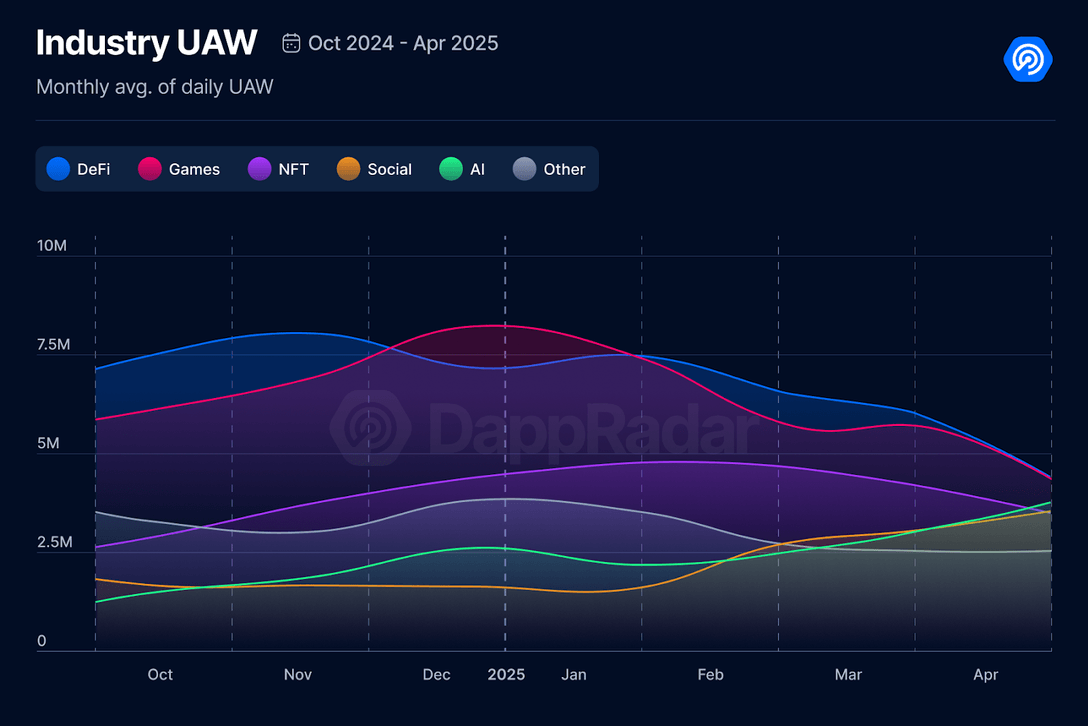
Data confirms this. In April, the number of daily unique active wallets (dUAW) for blockchain games was 4.8 million, a 10% decrease from the previous month. The dominance of games in the dapp industry is also declining. While it was once the leading category, DeFi has regained focus due to the memecoin wave. Today, AI is rapidly catching up, holding a 16% share, while games and DeFi each account for 21%.
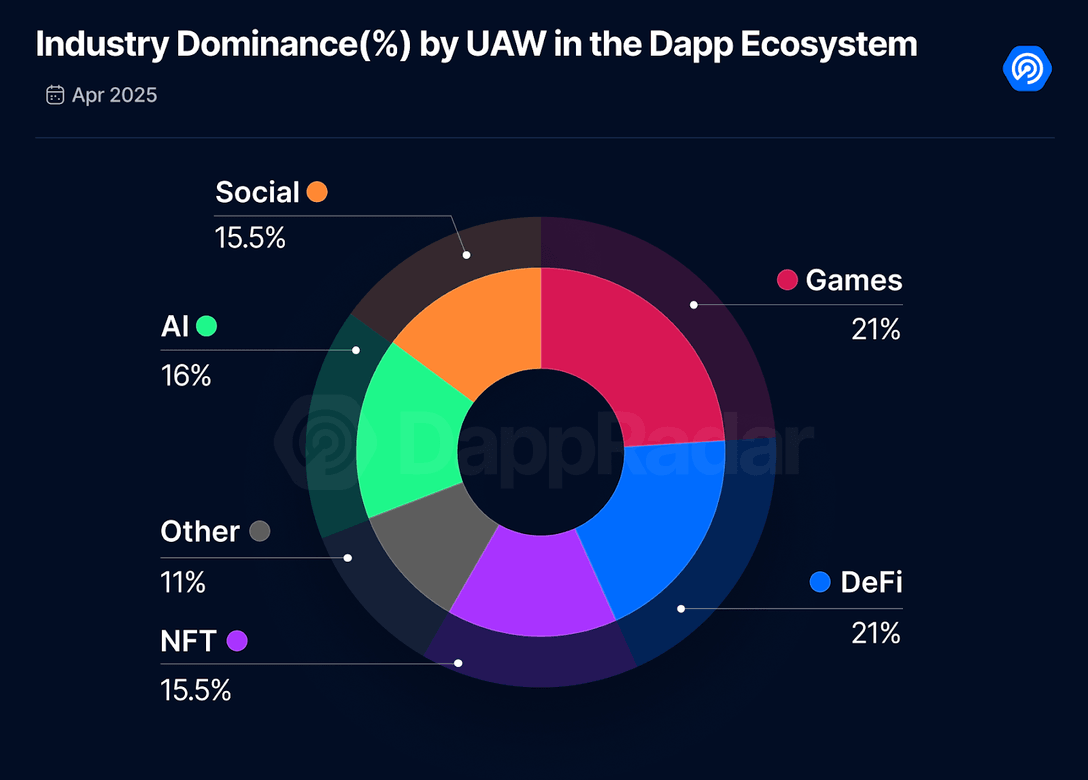
But development has not slowed; teams are still building, and funding continues to flow into the sector. It is no longer as reliant on speculative "play-to-earn" mechanisms but is increasingly driven by users interested in gameplay, asset ownership, and community.
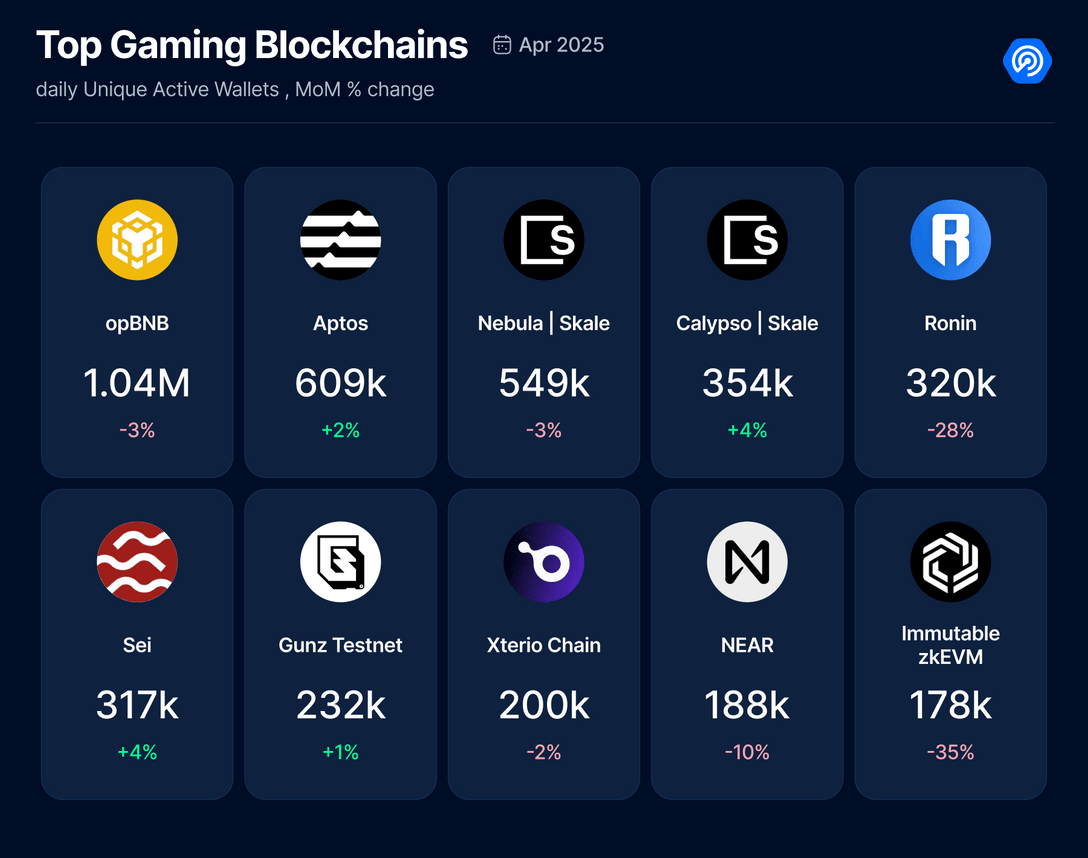
Familiar names dominate the top game chains, with opBNB once again at the top. To delve deeper, the activity of game DApps on each chain was analyzed, revealing some patterns.
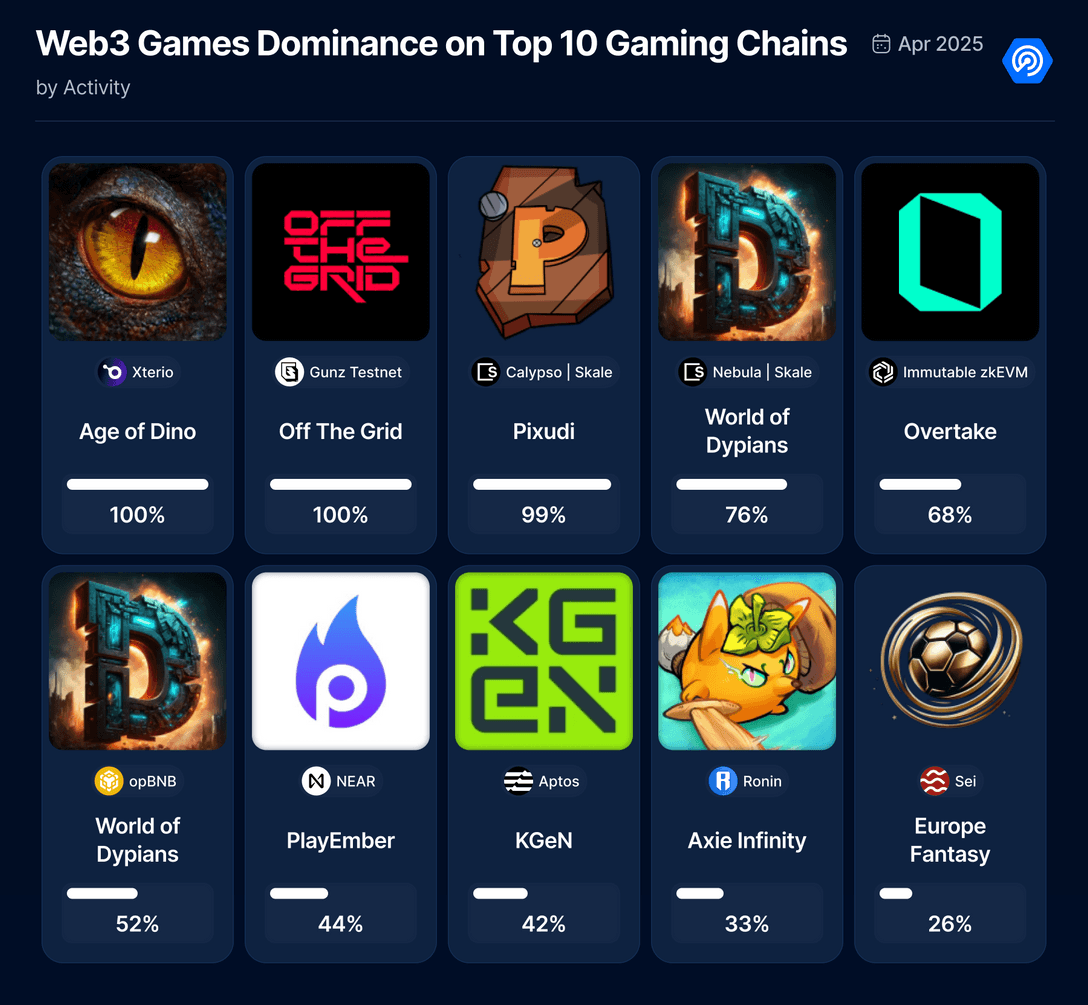
- World of Dypians accounts for 52% of activity on opBNB and as high as 76% on Nebula (SKALE).
- On Ronin, although Axie Infinity is the top-ranked game, its activity share is only 33%, indicating that Ronin is actively shedding its identity as the "Axie Chain."
- Off The Grid has 100% activity on its dedicated GUNZ testnet, and Age of Dino also boasts 100% activity on Xterio.
These data reveal a deeper issue: some chains are clearly built around flagship games, while chains like Ronin are evolving into ecosystems for multiple games. As competition intensifies, it will be interesting to see which chains can successfully develop into broader comprehensive gaming hubs and which remain limited to a single IP.
2. April Game Leaders
Each month, we focus on the top ten games ranked by activity, and April did not bring many surprises, with some of the most active projects continuing to make progress.
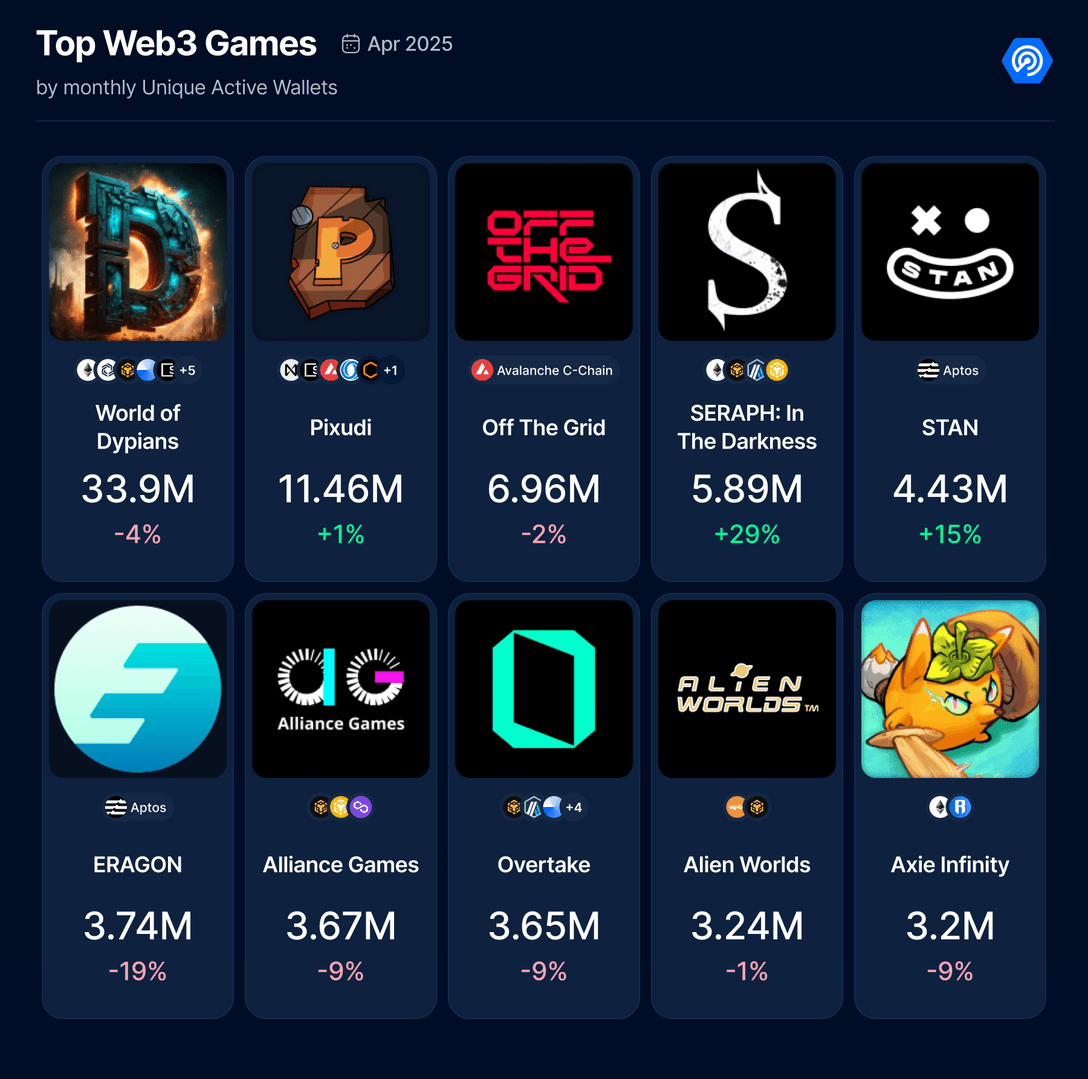
Off the Grid — GUNZ Mainnet Now Live
Off the Grid (OTG) is a cyberpunk-style battle royale game launched by Gunzilla Games, which made significant progress in April. Around April 17, the team activated its custom GUNZ blockchain on Avalanche and launched mainnet nodes, establishing the core infrastructure for the in-game economy.
OTG is still in early testing, but the launch of its mainnet indicates that a full release is getting closer. Notably, it is the first Web3 game playable on PS5 and Xbox One Series. Gunzilla's ecosystem model includes node rewards and revenue buybacks through the GUN token, with increasing speculation about a full release in the coming months.
Axie Infinity — Season Ongoing
Axie Infinity attracted player participation in April through multiple competitions on the Ronin network:
- Axie Classic Season 9 (running until the end of May) — Total prize pool of 35,000 AXS
- Origins Season 13 qualifiers began on April 22
- The playoffs for Season 12 have also concluded
Sky Mavis is reallocating resources towards the upcoming massively multiplayer online role-playing game Atia's Legacy. As part of this transition, the experimental center "Project T" has been closed. Players seem very interested in this Axie MMO game, with pre-registration users reaching 2.5 million by mid-March.
Seraph — Third Season Officially Launched
The dark fantasy action RPG Seraph launched its third season on April 27, introducing new dungeons, equipment, and a free season pass. This update also introduced:
- Stall licenses (player-operated shops)
- An on-chain asset yield system that converts in-game achievements into token rewards
The focus remains on a sustainable P2E mechanism that rewards players' efforts and time, rather than just token trading.
Comprehensive Game Updates
Star Atlas introduced two new PvP modes:
- Gunfight — A deathmatch mode where kills upgrade weapons
- Territory Control — A team-based map control gameplay
The Sandbox continued the features of Alpha Season 5, launching new UGC games (such as SABOTAJ) and brand experiences like "Jurassic World." This season will run until May 12 and offers a $1 million prize pool, including SAND, NFT, and LAND rewards.
Cambria postponed the launch of its second season, The Paymasters, originally scheduled for April 7. This MMORPG inspired by RuneScape runs on Blast and Ronin, with its "risk-reward" model requiring players to stake assets for high-return dungeon challenges. Developers promised to notify 24 hours before the new season starts.
Gods Unchained announced a significant backend migration: moving from Immutable X to zkEVM to support smart contracts and achieve broader interoperability. The token bridge is expected to open by the end of May, at which point players will automatically complete the migration.
3. Ecosystem Development and Collaboration
April witnessed a series of developments and collaborations within the ecosystem, reflecting that Web3 gaming has entered a more mature stage. From major publishers testing new models to the opening of chain infrastructure, the sector continues to evolve strategically.
Traditional Publishers in Web3
Mainstream gaming companies are still experimenting with blockchain technology — some have achieved greater success.
Sega officially launched KAI: Battle of Three Kingdoms, incorporating NFTs and "play-to-earn" mechanisms into a well-known IP.
Meanwhile, Square Enix announced that it would shut down the Symbiogenesis project in July 2025 due to poor performance (with NFT trading volume at only about 125 ETH and the floor price nearly zero in April).
Square Enix will remain in the Web3 space, but this outcome indicates that merely transplanting NFTs into games is not enough. Sega's collaboration-driven strategy contrasts sharply with Square Enix's solitary approach, highlighting a key lesson: native Web3 experiences are crucial.
In April, Ubisoft announced a partnership with Immutable. The two will jointly launch a collectible card game based on the Might & Magic franchise, bringing the Might and Magic series into the blockchain space. The game is scheduled to launch by the end of this year.
Netmarble x Immutable
Netmarble has made a significant ecosystem announcement through its Web3 division, Marblex. The South Korean giant plans to launch seven blockchain games on the Immutable platform in 2025, including the game "Tokyo Beast," which merges esports with NFT mechanics.
Immutable's zkEVM will support these games, and both parties seem confident that this collaboration can bring blockchain gaming to a broader audience. Marblex has also introduced a new mascot, "Goby," and the slogan "Fun First," marking its deeper foray into Web3.
Ronin Opens to Third-Party Developers
Ronin, once the standalone game chain for Axie Infinity, has officially opened to third-party developers. April saw significant achievements:
- Avarik Saga, initially on Arbitrum, has expanded to Ronin to benefit from lower fees and a game-prioritized ecosystem.
- Realms of Alurya has abandoned the Treasure ecosystem and migrated to Ronin.
- Community Gaming launched a prediction market dapp (FORKAST) on Ronin.
As more games join, Ronin is transforming from a chain limited to Axie into a broader ecosystem. However, this has also brought some troubles, as the developers of "Ragnarok: Monster World" have moved their game to another chain, allegedly breaching their contract.
Arbitrum and Dedicated Chains
Through its Orbit program, Arbitrum is enabling custom game subnets. One notable example gaining attention in April is Studio Chain, built in collaboration with Karrat and the Arbitrum Foundation.
The flagship title on this chain is "My Pet Hooligan," a battle royale game with in-game asset trading volume exceeding $78 million. Currently, the game is fully migrating its token (KARRAT) and gameplay to Studio Chain. This indicates a broader trend: developers are turning to dedicated chains to customize game performance and in-game economies.
4. Investment Down 69%, but "Smart" Capital Flows into Infrastructure
Investment activity in the blockchain gaming and metaverse sectors nearly came to a halt in April, but there are still some cautiously optimistic reasons. The total funds raised this month were only $21 million, a 69% decrease from March. The macroeconomic situation is also unfavorable, with ongoing uncertainty affecting investor sentiment.
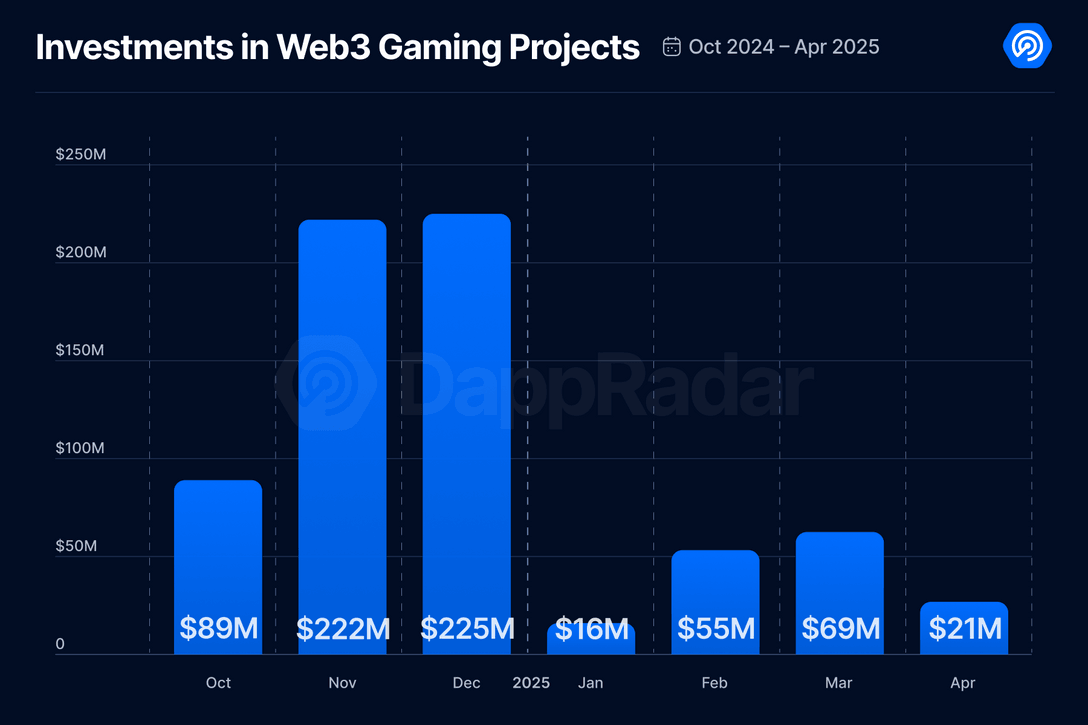
However, despite the overall low numbers, previously announced ecosystem funds have begun to yield results. The most notable is Arbitrum's $200 million ARB gaming fund, which has officially been renamed Arbitrum Gaming Ventures. After completing backend work in April, it announced its first investments in early May.
The first $10 million has been allocated to five projects:
- Wildcard: A Web2 card game from Steam that has now transitioned to Arbitrum;
- Proof of Play: A blockchain service provided by the developers of Pirate Nation;
- XAI Network: One of the leading game Layer-3 chains built on Arbitrum;
- Hyve Labs: A multi-platform game publishing platform;
- T-Rex: A gaming application chain;
Arbitrum is not investing in entirely new independent teams but is betting on established studios and experienced founders to ensure ecosystem growth.
Notably, as of now, 66% of all funds in 2025 have been allocated to infrastructure development. This indicates that, with the continued entry of traditional gaming companies and significant investments in the ecosystem, confidence in Web3 gaming is not only intact but is becoming more mature.
Investors are now focusing more on sustainable models, player engagement, and actual retention rates, rather than just token speculation. This suggests that the market is clearly in a reset mode. Funding is harder to come by, but this may not be a bad thing. Weaker projects are being weeded out, and capital is flowing towards developers laying the groundwork for the next generation of blockchain games.
5. May Outlook
May will see significant updates, Alpha test releases, and content updates that could shake up the Web3 gaming space.
MapleStory N
Nexon's "MapleStory N" will officially launch on May 15, built on Avalanche's "Henesys" subnet. This blockchain game comes from a well-known traditional IP, and early data shows strong performance:
- The number of registered wallets during testing reached 1 million.
- Over 31.5 million transactions have been processed.
Treeverse
The reward event for Season 1 of "Treeverse" is ongoing, featuring daily tasks and leaderboards, as well as in-game/NFT rewards.
Gigaverse
"Gigaverse" has launched two features aimed at enhancing player retention and growth:
Illuvium
In May, "Illuvium: Zero" may officially release. The ILV token is performing strongly, and the team is pushing hard for the official launch, with more news likely to be announced soon.
6. Conclusion
April was not a record-breaking month for blockchain gaming, but that's okay; the industry is readjusting. The speculative frenzy is cooling down, but developers have not stopped their progress. Games continue to be released. The ecosystem is expanding, and infrastructure is maturing.
The decline in user activity (dUAW down 10%) and lower investment amounts (only $21 million raised) reflect the current risk appetite of the market. However, at the same time, we have witnessed the first deployments of Arbitrum's $200 million fund, new studios joining Immutable, and Ronin opening up to external developers. This is not explosive growth, but foundational work.
Major publishers continue to emerge, but real progress is being made by those publishers collaborating with native Web3 teams. Additionally, priorities have shifted significantly from unsustainable token models to gameplay, interoperability, and actual user retention.
Related: Top 10 Web3 Games to Watch in May
免责声明:本文章仅代表作者个人观点,不代表本平台的立场和观点。本文章仅供信息分享,不构成对任何人的任何投资建议。用户与作者之间的任何争议,与本平台无关。如网页中刊载的文章或图片涉及侵权,请提供相关的权利证明和身份证明发送邮件到support@aicoin.com,本平台相关工作人员将会进行核查。




